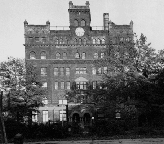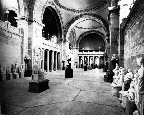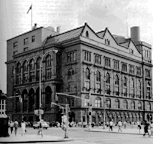 |
 |
 |
Historical Landmark Project
NYC and the nyVRMLsig
the historical landmark project is a highly collaborative hands-on 3D project designed to:
- pay tribute to New York architecture
- promote VRML
- promote the artists who create VRML
- promote the organizations interested in VRML
(who also occupy landmark buildings)
- promote the technology firms who make VRML tools
|
|
Overview
Portfolio v. Non-Portfolio VRML Models
Teams
Project Specifications
|
Overview
The landmark project is a deliberate plan to get VRMLSIG artists involved with the City of New York and the corporations who occupy landmark buildings. By creating 3D models of their building, we will treat these organizations as clients. Schools with landmark buildings on their campuses will also be treated as clients. An invitation has been extended to students at participating schools to join the NYVRMLSIG and build models.
This project represents an opportunity to rehearse interaction with a client. In the process, many clients will discover VRML applications that may, at some future date, lead to real projects for the VRMLSIG artists.
Even at the very start of this project, ideas for VRML applications have emerged. For example, the fact that Metropolitan Life Insurance has space to rent in their building at 11 Madison Avenue has inspired us to invite real estate firms to view completed models later this year. The MTA is interested in spreading news about their $178 million dollar renovation project at Grand Central Station. Two leading technology firms, NAFT and Transactions Information Systems happen to occupy historical landmark buildings and also happen to be involved with 3D technology. |
 |
Portfolio v. Non-Portfolio VRML Models
Recognizing that not all VRMLSIG members may be ready to rehearse the steps for a real project, we've created two categories for VRML models:
Portfolio projects will be organized into teams, each of which will have a team leader. These projects will involve research, 3D modeling, client review and client changes. Portfolio projects will revolve around problem solving and the invention of innovative new VRML applications that are client-centered.
Individuals who wish to work alone or who wish to create abstract models should consider the non-portfolio category. In this category, teams may also be formed and organized with a team leader. We've estimated that this category may be of interest to some of our most advanced members who don't need portfolio pieces.
In addition to the modeling teams, an HTML-Web Graphics team and an Educator team will also be formed. Thanks to resource contributions from schools, technology forums and the four-member VRMLSIG art director team, every participant will have an opportunity to take advantage of classroom instruction and guidance from professionals. |
  |
Teams
VRMLSIG members who have joined team projects include:
-
- Building Team: Metropolitan Life Insurance
- Patrick Jennings
- Alex Shamson
- Building Team: Pratt Institute
- Chiamu Lin
- Building Team: Grand Central Station
- Ron Johnson
- Michael Storch
- William Bonilla-Ward
- George Cade
- Sonya
- Linda Vignor
- Building Team: Cooper Union
- Matt O'Donnell
- Dan O'Donnell
- Building Team: Puck Building
- David Halbstein
- Building Team: United States Realty Building
- Paul Wanuga
- Building Team: NYU (Washington Square)
- Victorio Marchi
- Paula Murgia
- Educators Team
- Paul Marino
- Alex Shamson
- Joe Dellinger
- Marek Walczak
- HTML and Web Graphics Team
- Mary Jo Fahey
- Kathy Forer
- Paul Marino
- Marek Walcek
- Alex Shamson
- Michael Storch
- Marek Walcek
- Research and Project Public Relations
- Mary Jo Fahey
- Lisa MacKenzie
- Leslie Kesselring
Interested participants may join these teams by sending an e-mail message to Mary Jo Fahey at [email protected] |
 |
Project Specifications
-
- Suggested Size
- The suggested file size includes the total size per world including texture maps and inlines: 100K
- Standard of Excellence
- In portfolio projects, this will be determined by the client.
- Degree of Realism
- In portfolio projects, this will be determined by the client.
- Teams should pick a part of a building and a point of interest.
- VRML 1.0 or 2.0
- Portfolio projects must conform to the VRML 2.0 spec.
- Non-portfolio project may be VRML 1.0 or VRML 2.0
(Note: conversion tools are available for artists using VRML 1.0 tools).
- Browser compatibility
- All projects should be compatible with 2.0 browsers.
- Dimensioning
- VRML 2.0 is based on meters (default to human scale or 1.6 meters).
- Ownership
- The artist retains all rights and licenses a VRML project to the SIG or to a participating organization for a limited amount of time. Each team member owns an equal share in a project. Licenses may be extended.
- Suggested roles for each group
(Note: suggestions include administative positions; each group must form their own creative positions)
- Project leader
- email person (may be the same person).
|
 |
Landmark Project Mailing List
Many thanks to VRMLSIG member Ross von Burg and to TKI.NET for Website Hosting |
| |
email  |





